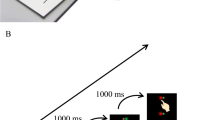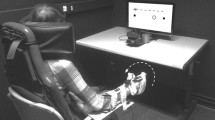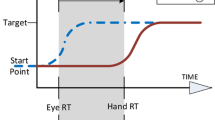Abstract
The kinematics of upper limb movements and the coordination of eye and hand movements are affected by ageing. These age differences are exacerbated when task difficulty is increased, but the exact nature of these differences remains to be established. We examined the performance of 12 older adults (mean age = 74) and 11 younger adults (mean age = 20) on a multi-phase prehension task. Participants had to reach for a target ball with their preferred hand, pick it up and place it in a tray, then reach for a second target ball and place that in the same tray. On half the trials (stabilising condition), participants were required to hold the tray just above the surface of the table with their non-preferred hand and keep it as still as possible. Hand and eye movements were recorded. Older adults took longer to complete their movements and reached lower peak velocities than the younger adults. Group differences were most apparent in the stabilising condition, suggesting that the added complexity had a greater effect on the performance of the older adults than the young. During pickup, older adults preferred to make an eye movement to the next target as soon as possible, but spent longer fixating the current target during placement, when accuracy requirements were higher. These latter observations suggest that older adults employed a task-dependent eye movement strategy, looking quickly to the next target to allow more time for planning and execution when possible, but fixating on their hand and successful placement of the ball when necessary.




Similar content being viewed by others
References
Abrams RA, Pratt J, Chasteen AL (1998) Aging and movement: variability of force pulses for saccadic eye movements. Psychol Aging 13(3):387
Burke MRF, Poyser C, Schiessl I (2014) Age-related deficits in visuospatial memory are due to changes in preparatory set and eye–hand coordination. J Gerontol B Psychol Sci Soc Sci. doi:10.1093/geronb/gbu027
Carnahan H, Marteniuk RG (1991) The temporal organization of hand, eye and head movements during reaching and grasping. J Mot Behav 23:109–119
Coats RO, Wann JP (2011) The reliance on visual feedback control by older adults is highlighted in tasks requiring precise endpoint placement and precision grip. Exp Brain Res 214(1):139–150
Coats RO, Wann JP (2012) Reaching a better understanding of the control of bimanual movements in older adults. PLoS One 7(10):e47222
Cooke JD, Brown SH, Cunningham DA (1989) Kinematics of arm movements in elderly humans. Neurobiol Aging 10:159–165
Darling WG, Cooke JD, Brown SH (1989) Control of simple arm movements in elderly humans. Neurobiol Aging 10(2):149–157
Flanagan JR, Johansson RS (2003) Action plans used in action observation. Nature 424(6950):769–771
Goggin NL, Stelmach GE (1990) Age-related differences in a kinematic analysis of precued movements. Can J Aging 9(4):371–385
Helsen WF, Elliott D, Starkes JL, Ricker KL (2000) Coupling of eye, finger, elbow, and shoulder movements during manual aiming. J Mot Behav 32(3):241–248
Ketcham CJ, Seidler RD, Van Gemmert AWA, Stelmach GE (2002) Age-related kinematic differences as influenced by task difficulty, target size, and movement amplitude. J Gerontol B Psychol Sci 57B:54–64
Komilis E, Pelisson D, Prablanc C (1993) Error processing in pointing at randomly feedback-induced double-step stimuli. J Mot Behav 25:299–308
Land MF, Hayhoe M (2001) In what ways do eye movements contribute to everyday activities? Vis Res 41:3559–3565
Neggers SFW, Bekkering H (2000) Ocular gaze is anchored to the target of an ongoing pointing movement. J Neurophysiol 83:639–651
Prablanc C, Pelisson D, Goodale MA (1986) Visual control of reaching movements without vision of the limb. 1. Role of retinal feedback of target position in guiding the hand. Exp Brain Res 62:293–302
Pratt J, Chasteen AL, Abrams R (1994) Rapid aimed limb movements: age differences and practice effects in component submovements. Psychol Aging 9(2):325–334
Pratt J, Dodd M, Welsh T (2006) Growing older does not always mean moving slower: examining aging and the saccadic motor system. J Mot Behav 38(5):373–382
Rand MK, Stelmach GE (2011) Effects of hand termination and accuracy requirements on eye–hand coordination in older adults. Behav Brain Res 219(1):39–46
Säfström D, Johansson RS, Flanagan JR (2014) Gaze behavior when learning to link sequential action phases in a manual task. J Vis 14(4):3
Seidler-Dobrin RD, Stelmach GE (1998) Persistence in visual feed-back control by the elderly. Exp Brain Res 119:467–474
Serrien DJ, Swinnen SP, Stelmach GE (2000) Age-related deterioration of coordinated interlimb behavior. J Gerontol B Psychol Sci Soc Sci 55(5):P295–P303
Spijkers W, Spellerberg S (1995) On-line visual control of aiming movements? Acta Psychol 90:333–348
Stelmach GE, Amrhein PC, Goggin NL (1988) Age differences in bimanual coordination. J Gerontol Psychol Sci 43(1):18–23
Warabi T, Noda H, Kato T (1986) Effect of aging on sensorimotor functions of eye and hand movements. Exp Neurol 92:686–697
Weir PL, MacDonald JR, Mallat BJ, Leavitt JL, Roy EA (1998) Age-related differences in prehension: the influence of task goals. J Mot Behav 30(1):79–89
Woodworth RS (1899) The accuracy of voluntary movement. Psychol Rev 3(3, Suppl. 13):1–119
Acknowledgments
The authors would like to thank the Economic and Social Research Council (ESRC) http://www.esrc.ac.uk/for funding the first author’s Ph.D. for which these data were collected.
Author information
Authors and Affiliations
Corresponding author
Ethics declarations
Conflict of interest
The authors declare that they have no conflict of interest.
Rights and permissions
About this article
Cite this article
Coats, R.O., Fath, A.J., Astill, S.L. et al. Eye and hand movement strategies in older adults during a complex reaching task. Exp Brain Res 234, 533–547 (2016). https://doi.org/10.1007/s00221-015-4474-7
Received:
Accepted:
Published:
Issue Date:
DOI: https://doi.org/10.1007/s00221-015-4474-7




